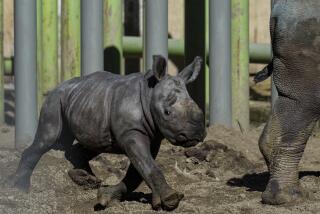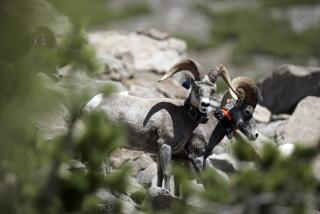Rhino Population Is Charging Back From Brink of Extinction
- Share via
NAIROBI NATIONAL PARK, Kenya — A 5-year-old rhinoceros with a tranquilizing dart in her rump staggered through scrub brush until she fell with a thud in the dusty wash of a helicopter’s blades.
The rhino is a victim of her own species’ survival success. She’s being moved to a region less crowded with rhinos.
She might lose part of her distinctive horn on the trip, but there’s less danger these days that she will be killed and the horn carved into dagger handles or ground up as medicine.
Under the watchful eyes of park rangers and the protection of international laws, the population of African black rhinos, once almost extinct, is on the rebound.
Already heavily decimated by white hunters in the 19th century, African rhinos beginning in the 1970s decreased by 96% as prices for rhino horn soared and agriculture hemmed in their habitat.
Now, under strict control, the population of black rhinos has risen to at least 2,500 in and around parks and on private land in eastern and southern Africa, an increase of 100 from three years ago.
The white rhino population is doing even better. There are 7,600 on the continent, most of them in South Africa.
“It shows that if you put in the commitment, you can save these animals,” said Esmond Bradley Martin, consultant to the World Wide Fund for Nature and an expert on the trade in endangered species.
National and international efforts to crack down on poachers and those who sell rhino horns to make dagger handles in Arabia and medicines in east Asia are working, he says.
In fact, there were 64 of the two-horned beasts at Nairobi National Park, too many for its 44 square miles.
The population boomlet is the result of the Kenya Wildlife Service’s 12-year-old policy of providing fenced sanctuaries to protect breeding rhinos. Kenya now has 425 black rhinos, up from 350 in 1987.
Not a single rhino is known to have been lost to poachers in four years.
“In the short term, sanctuaries or intensive protection zones hold the best hope for the recovery of the black rhino,” said Timothy Oloo, director of the wildlife service’s rhino program.
As evidence that the policy is working, the young female rhino zapped by the tranquilizer was being moved to a closely guarded but unfenced area at Tsavo National Park. In one of the worst slaughters in history, poachers killed at least 8,000 rhinos there in the 1970s and early 1980s, nearly wiping out the population.
From a helicopter, the wildlife services’ chief veterinarian, John Wambua, fired a 2-inch-long, drug-filled dart into the rhino’s well-muscled haunch.
Within minutes, she toppled.
Rangers swiftly blindfolded her and used a chain saw to lop off the tip of her 12-inch horn, not to deter poachers but to prevent her from breaking her horn off as she was loaded in a crate and transported 130 miles southeast to Tsavo.
An antidote failed to revive the groggy 2,600-pound animal, so the reluctant rhino was provoked to action by a blast of water in her ear.
“They’ll charge anything, from a steam locomotive to a butterfly,” Martin said, standing well clear of the angry animal. Dozens of rangers tugged on a rope around the rhino’s neck to pull her into the crate.
Eight rhinos recently were moved from Nairobi to Tsavo National Park. There are now 19 wild rhinos in the sprawling reserve, each equipped with a radio transmitter so that rangers can keep track of them.
Poachers armed with modern weapons killed nearly all of Africa’s black rhino population in the 1970s and ‘80s. The population fell from 65,000 in 1970 to 2,400 in 1992.
The poachers were motivated by a dramatic expansion in the market for African rhino horns. In Yemen, the rhino horn dagger handle--traditionally a status symbol of the rich--suddenly became affordable to thousands of Yemeni men flush with earnings from Saudi oil fields.
The price for rhino horn shot up from about $15 a pound to almost $300 a pound in the 1970s, enough to buy off some of the park rangers who were supposed to protect the animals.
Alarmed, conservationists put pressure on range countries and importers of rhino horn.
Now Kenya has 425 black and 122 white rhinos; Zimbabwe has 315 blacks and 138 whites; Namibia has 598 blacks and 107 whites; and South Africa has 1,024 blacks and 7,095 whites.
“These countries have put more resources into looking after the rhinos,” Martin said. “Also there is a general awareness of the importance of saving rhinos.”
“There’s no great mystery to this,” he said, outlining his prescription to save the rhino.
“You need to have enough manpower and equipment on the ground to look after the rhinos. You need a good intelligence service within the country, and also a good one outside to catch the international traders. And also what you need to do is prompt the use of substitutes.”
It costs at least $740 per square mile per year to provide a safe haven for rhinos, Martin said.
“The most effective money is put into intelligence,” Martin said. The best example is Namibia, where nearly every poacher and middleman is caught.
In Zimbabwe, for example, a shoot-to-kill policy against poachers did not work. More than 160 were shot, but the country has lost most of its rhinos.
In addition to better policing in countries with rhinos, international agreements banning the trade of endangered species also have been effective.
Asia, especially South Korea, China and Taiwan, are doing a better job now of preventing the trade, Martin said. “You just don’t see the stuff there anymore.”
As much as 4 tons a year were shipped to Yemen in the 1970s. That fell to 1.5 tons in the early 1980s, and about 200 pounds annually in recent years. Yemen outlawed horn imports in 1982.
Despite the drop in supply, the price of rhino horn in Yemen has been stable since 1985 at about $50 a pound.
“The explanation is, they’re using substitute materials in a huge way,” Martin said.
Yemenis make 150,000 new daggers a year, mostly from water buffalo horn or wood. More recently, plastic and semiprecious stones such as agate have been used, replacing the highly valued multihued, translucent rhino horn.
The distinctive spike on the rhino’s head is made not of bone but of keratin.
In east Asia, substitutes for rhino horn are being used as medicine.
Despite widespread belief, rhino horn is not used as an aphrodisiac in Asia, Martin said.
The campaign to promote the use of substitute materials must continue, he said.
“We need to make a very simple point. We need to tell dagger makers, traditional healers and doctors that if they continue to use rhino horn, there won’t be any rhinos left,” Martin said.
More to Read
Sign up for Essential California
The most important California stories and recommendations in your inbox every morning.
You may occasionally receive promotional content from the Los Angeles Times.










